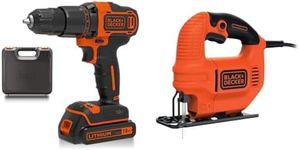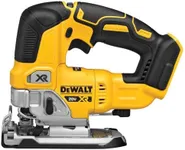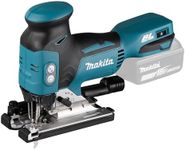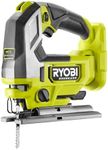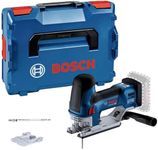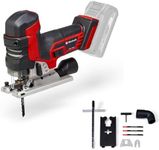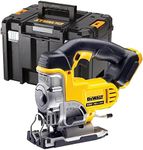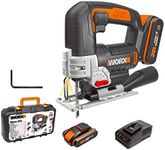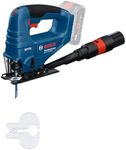Buying Guide for the Best Jig Saws
When choosing a jigsaw, it's important to consider the type of projects you plan to undertake. Jigsaws are versatile tools used for cutting curves and intricate shapes in various materials like wood, metal, and plastic. The right jigsaw for you will depend on the frequency of use, the materials you will be cutting, and the level of precision you require. Understanding the key specifications will help you make an informed decision and ensure that the jigsaw you choose meets your needs effectively.Power SourceJigsaws can be powered by electricity or batteries. Corded jigsaws offer consistent power and are ideal for heavy-duty tasks or prolonged use, as they don't require recharging. They are best suited for workshop environments where a power outlet is readily available. Cordless jigsaws, on the other hand, provide greater mobility and are convenient for on-site work or projects that require frequent movement. However, they may have limited runtime depending on the battery capacity. Choose a corded jigsaw if you need continuous power and a cordless one if portability is more important for your projects.
Motor PowerMotor power in jigsaws is measured in amps for corded models and volts for cordless models. Higher motor power allows the jigsaw to cut through tougher materials more easily and perform more demanding tasks. For light to medium tasks, such as cutting thin wood or plastic, a motor power of around 4 to 5 amps (or 18 volts for cordless) is sufficient. For more intensive work, like cutting metal or thick hardwood, look for a jigsaw with a motor power of 6 amps or more (or 20 volts for cordless). Consider the materials you will be working with to determine the appropriate motor power.
Stroke RateThe stroke rate, measured in strokes per minute (SPM), indicates how fast the blade moves up and down. A higher stroke rate allows for faster cutting, which is beneficial for straight cuts and softer materials. Jigsaws with variable speed settings offer more control, allowing you to adjust the stroke rate according to the material and type of cut. For general use, a jigsaw with a stroke rate of 2,500 to 3,000 SPM is adequate. If you need to cut a variety of materials or require precision, opt for a model with adjustable speed settings.
Orbital ActionOrbital action refers to the movement of the blade in a slightly circular motion, which can make cutting faster and more efficient. Jigsaws with orbital action settings allow you to adjust the aggressiveness of the cut. For straight cuts in soft materials, a higher orbital setting is useful, while for intricate or curved cuts, a lower setting or no orbital action is preferable. If you plan to work on diverse projects, choose a jigsaw with adjustable orbital action to provide flexibility in your cutting tasks.
Blade Type and CompatibilityJigsaws use different types of blades depending on the material being cut. T-shank blades are the most common and offer easy installation and better stability. U-shank blades are less common but still used in some models. The material of the blade, such as high-speed steel or bi-metal, affects its durability and cutting capability. Ensure the jigsaw you choose is compatible with the blade types you need for your projects. Consider the materials you will be cutting and select blades that are designed for those specific materials to achieve the best results.
Bevel CapacityBevel capacity refers to the ability of the jigsaw to tilt and make angled cuts, typically up to 45 degrees. This feature is important for projects that require angled cuts, such as creating beveled edges or fitting pieces together at an angle. If your projects involve a lot of angled cuts, look for a jigsaw with an easy-to-adjust bevel feature. For general use, a standard bevel capacity of 45 degrees is usually sufficient, but ensure the adjustment mechanism is user-friendly and precise.

